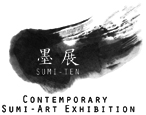墨絵展について
墨絵展(現墨展)は1978年第1回展が開かれた。「現代絵画における墨の復権」が旗印だった。
当時墨は画材として、表現として現代作品という範疇ではほとんど顧みられていなかった。そんな状況下、個性の強い墨作品を発表し続けてきた山本政雄がやはり墨を手がける現代作家・佐藤多持、水谷勇夫とかたらい、評論家・針生一郎の協力のもとに「墨絵展」を立ち上げた(銀座・地球堂ギャラリーなどが会場協力)。
墨絵展は、今日的視点からの新しい墨表現を求めて、日本画・水墨画系の作家ばかりでなく油画家、デザイナー、イラストレーターなどに出品を求めた。「原爆の図」の
丸木位里をはじめ利根山光人、朝倉摂らが呼応して出品し、異色の墨表現展として多くの注目を集めた。その後出品者の交代はあったが、上記3人の提唱者(いずれも物故された)を中心に回を重ねてきた。現在も発足当初の理念は継承され、さまざまの表現が会場で発言をしている。
2002年には25回記念展を中国・上海の劉海粟美術館で中国側作家を交えて「日本現代墨表現展」として開催した。その際の中国人作家の、アーティスト自身と筆と墨と紙、そして水との濃密な関係の印象が今でも強く残っている。
2008年には30回記念展を麻布・元麻布ギャラリーで開催し、墨によるパフォーマンスを含む多彩な表現が美術館クラスの広い会場を充実した墨空間として提示した。
墨絵展を支える「自由な発想で墨を・自由な表現を墨で」という理念の中で、墨が持つ表現の強さ、豊かさ、美しさをあらためて追求しようという姿勢が最近とみに強まっている。
墨絵展は会員制のグループではなく、毎回世話人が出品を招請して展覧会が持たれる
システムである。一回の出品者は初期の十数名から最近は30名前後と増え、これまでの出品者は実数で100名をはるかに超えていると思われる。観客数も増え、「異色」ばかりでなく「今日の墨表現」を追求する切磋琢磨の場として、また、一定レベルを保った墨表現展として多方面から評価を得ている。
*2017 年に「墨展」に名称を変更しました。
About 墨展=Sumi-ten
"SUMIE-TEN(renamed to Sumi-ten in 2017) - Contemporary Sumi Art Exhibition" was first organized in 1978. The main objective was "the rehabilitation of sumi (Chinese ink) in contemporary painting".
At that time, sumi was almost not recognized as a form of expression in the field of contemporary art. In this context, Yamamoto Masao, who had been publishing sumi art works with strong personality, approached contemporary artists Satô Tamotsu and Mizutani Isao, who were also adepts of sumi, and they organized the first Sumie-ten exhibition with the help of art critic Hariu Ichiro. This first edition, like many others, was held in Chikyûdô Gallery, in Ginza.
Looking for new forms of expression in sumi art, the founders asked for the participation not only of nihonga or suibokuga artists, but also of oil painters, designers, illustrators, etc. Artists like Maruki Iri (famous for "Genbaku-no-zu"), Toneyama Kôjin, Asakura Setsu, etc. responded favorably, and Sumie-ten attracted much attention as a new and original sumi art exhibition. From then on, although they were some changes in the participants, exhibitions followed one another with the three founding members still present (now passed away). Today, the spirit of this pioneering period is still alive and, each year, various forms of sumi art interfere with each other in the exhibition space.
For the 25th anniversary, in 2002, Sumie-ten was organized at the Liu Hai Su Art Museum in Shanghai as the "Japan Contemporary Sumi Works Exhibition with Chinese Artists". The impression left by the intense relations Chinese artists have with brush, ink, paper and water, is still very strong in our memories.
In 2008, the 30th anniversary edition was held in Moto-azabu Gallery, in Azabu. Various forms of sumi expression, including a group performance, were presented in an exhibition space as large as an art museum.
Based on the concept "Free idea for sumi, free expression with sumi", which forms the cornering stone of Sumie-ten, the desire to discover again the richness of expression, the strength and the beauty of sumi is developing rapidly these years.
Sumie-ten is not a member club. The principle is that, each year, the representative invites other artists to participate. The number of participants has grown from a dozen of artists in the early days to nearly 30 artists in recent years, and the total number of participants since the beginning is probably larger than 100. The number of visitors is also increasing, and the exhibition receives high appreciation from many directions as a place not only of "originality", but also of assiduity in the pursuit of "today's sumi art", a place maintaining a certain level in the field of contemporary sumie.
